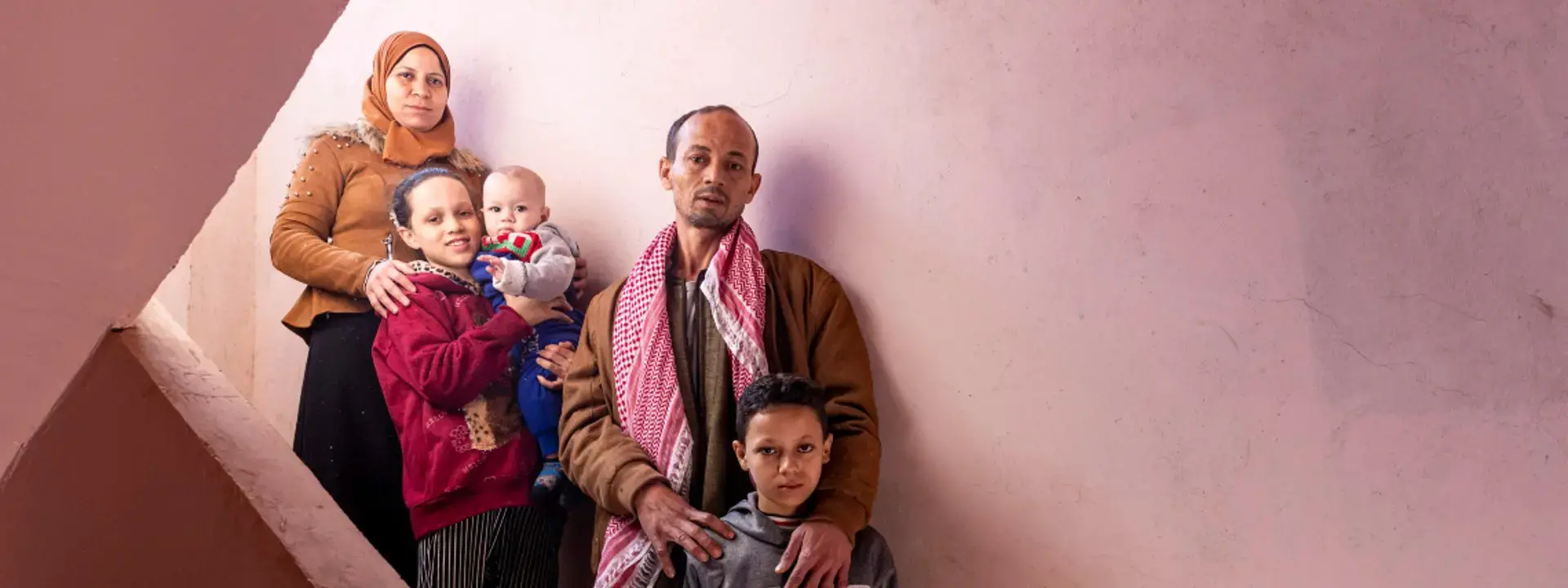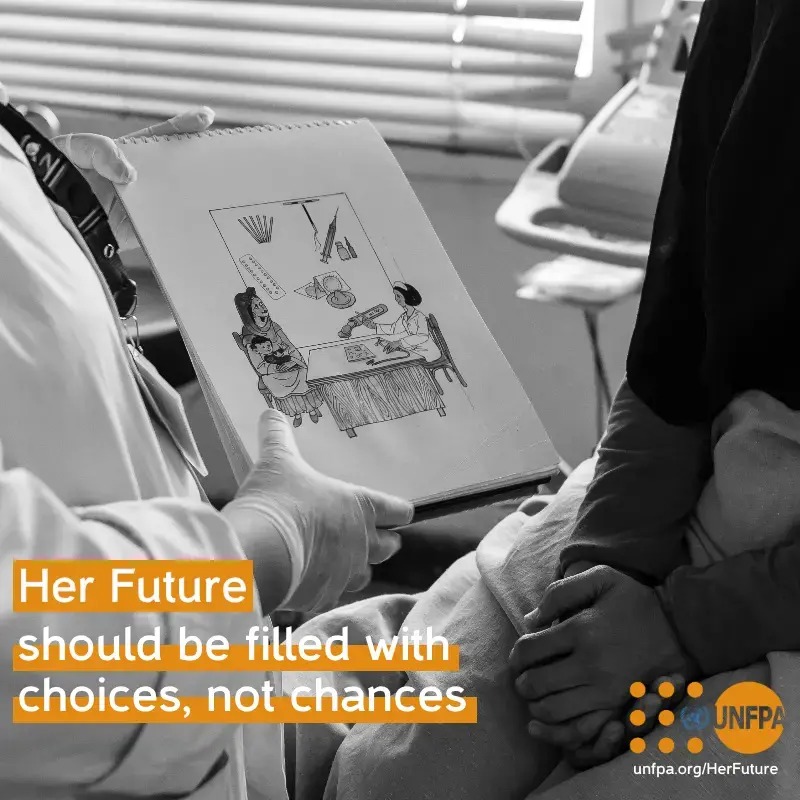Access to safe, voluntary family planning is a human right. Family planning is central to gender equality and women’s empowerment, and it is a key factor in reducing poverty. Yet, globally at least 222 million women who want to use safe and effective family planning methods are unable to do so because they lack access to information, services, commodities or the support of their partners or communities. Most of the women with an unmet need for family planning live in 69 of the poorest countries on earth.
UNFPA works to support family planning by: advocating for evidence and human rights-based family planning policies; ensuring a steady, reliable supply of high quality contraceptives; strengthening national health systems; gathering data and funding research to support this work. UNFPA also provides global leadership in advocating for improved access to family planning, by convening partners – including governments – to develop evidence and policies, and by offering programmatic, technical and financial assistance to low and middle-income countries.
Family planning in Egypt
Egypt is the most populous country in the Middle East and the third most populous country in Africa. The 2018 fertility rate is at 3.1, according to a study prepared by UNFPA, with data collected from the birth and mortality registration system implemented in collaboration between with the Ministry of Planning, Monitoring and Administrative Reform and the Ministry of Health and Population.
Fertility levels are the main determinant of population growth. Since 2006, fertility levels in Egypt were on an upward trend, reaching its highest level in 2014 at 3.5. Fertility levels decreased at a slow pace in 2017 (3.4) compared to 2014, but saw a sharp decrease in 2018, reaching 3.1.
According to the Egypt Demographic and Health Survey (EDHS) from 2014, 16 percent of births in the five-year period prior to the survey were not wanted at the time of conception. This percentage is slightly higher than the percentage of women who reported an unwanted birth in the 2008 EDHS (14 percent). Among the births not wanted at the time of conception, just over half (8 percent of all births) were not wanted at all.
Egypt’s government-led national family planning programme has succeeded in raising the Contraceptive Prevalence Rate, from 48 percent in 1991 to 59 percent in 2014 according the preliminary results from the DHS. Furthermore, the Total Fertility Rate has been slowly declining from 4.4 live born children per woman in 1988 to 3 in 2008 and then risen again in 2014. The government has attributed the high rate of contraceptive use to efforts to inform women about health services. Yet, the 2014 DHS found that one in eight married women was in need of family planning at the time of the survey. According to 2014 data, the unmet need for family planning in Egypt is 12.6 percent.
According to the same survey, only 30 percent of women were counseled on postnatal birth control methods. The lack of information can place women at risk of unwanted pregnancy soon after a previous birth, which may carry health risks and cause complications and death during pregnancy. Child spacing continues to be a challenge especially among young mothers, overall about 20 percent births occur within 24 months of the previous one.
The overall level of adolescent pregnancy (aged 15-19) has been on a slow but steady upward trend, from 9 percent in 2005 to 10 percent in 2008 and finally 11 percent in 2014. Seven percent of adolescents are already mothers, and 4 percent are pregnant with their first child, according to the EDHS 2014.
Modern family planning methods
The 2014 EDHS indicates that around 59 percent of currently married women in Egypt are using contraception. The most widely used methods are the IUD, the pill, and injectables, and three percent of these women cited that they use traditional methods. Thereby, 41 percent of married women were, as of 2014, not utilizing any family planning method.
The extents to which women utilize modern methods vary across regions. Urban women were more likely to be using modern contraceptives than rural women, and the lowest modern contraceptive use is among women residing in rural Upper Egypt.
The extents to which women utilize contraceptive methods also vary within age groups, whereby only 21 percent of married women aged 15-19 use contraception, compared to 73 percent among married women aged 35-39. Only two percent of ever-married women aged 15-49 regard use of family planning before a woman’s first pregnancy as appropriate.
Programme Overview:
Reproductive health (RH) is defined as a state of physical, mental, and social well-being in all matters relating to the reproductive system, at all stages of life. Everyone has the right to enjoy reproductive health, which is the basis for having healthy children, intimate relationships and happy families.
Reproductive health encompasses key areas of UNFPA vision: that every child is wanted; every birth is safe; every young person is free of HIV; and every girl and woman is treated with dignity and respect.
Reproductive Health is a core area for UNFPA, as well as a priority for the Egyptian government. UNFPA strives to support a sound RH policy that promotes access to quality RH services to broaden the opportunities of women and men to enjoy healthy lives.
Reproductive health, including family planning, is as an essential component for the wellbeing of the population; it has been receiving increasing attention and has now been adopted in almost all countries of the world.
Research, surveillance and data use for evidence-based decision-making and advocacy are strategic priorities for reproductive health. This programme serves the first outcome set in the UNFPA’s 10th Cycle Country Program “Women in reproductive age, men and young people have increased access to quality FP/RH services.” The programme seeks mainly to accelerate the achievement of universal access to reproductive health services through the reduction of inequities in accessing safe deliveries, and family planning services and to assist Egypt to meet the goals of MDG 5 around maternal health. Systems enhancement, advocacy and evidence based policy dialogue will be conducted at the central level, while capacity development and community-based interventions will focus on Assiut and Sohag.
Hence, for its 10th Country Programme Action Plan (2018-2022), Egypt and UNFPA have decided to focus on Assiut and Sohag, the 2 governorates with poor maternal health, poverty and health human resources indicators.
Egypt's Situation:
The 2014 DHS indicates that fertility rate significantly has increased after more than 20 years of decline. Between 1980 and 2008, Fertility dropped from 5.3 children per woman to 3.0 children per woman. But since2008, fertility has risen (by half a child) to 3.5 births after experiencing a plateau of 3 births for years (3.8 in rural areas, 2.9 in urban areas).
- 11% of women (15-49) years are pregnant or have had a live birth.
- One fifth of non-first births were born within 24 months of a prior birth interval.
- Contraceptive prevalence rate is 59% and desired fertility among ever-married women 15-49 is still at three children.
- According to 2014 data, the unmet need for family planning is approximately 13%
- There is a slight shift in family planning methods mix from long to short term contraceptives.
- There are misconceptions around fertility and family planning, in addition to concerns about side effects of contraceptives.
UNFPA interventions:
UNFPA, along with its partners, works to increase the use of voluntary, rights based family planning though improved supply of family planning services and commodities, increased demand for family planning, and enhanced population governance.
Through the EU Support to Egypt’s National Population Strategy, UNFPA works on the following outcomes:
Outcome 1: Scale up Family Planning services including contraceptive commodities and making them more accessible. ("supply-side").
Result 1 / Output 1.1: National costed implementation plan for FP developed and implemented
Result 2 / Output 1.2: Supply chain management strengthened in order to enhance quality of care and support choice of methods by reducing contraceptives' stockouts and equipment
Result 3 / Output 1.3: Enhanced capacity of service providers (5,500 FP clinics)
Result 4 Output 1.4: Family planning services and supply integrated into frequently used public sector maternal and new-born health services at Primary Health Care
Result 5 / Output 1.5: Public sector maternal/ new-born health facilities have regular FP supplies
Result 6 Output 1.6: Youth-friendly FP services integrated into Primary Health Centres for married young people
Result 7 / Output 1.7: FP services/supply extended to women whose mobility is constrained by social norms (14,000 MoHP outreach workers trained as a community health workers);
Result 8 / Output 1.8: FP extended to "women health clubs" revitalized as FP clinics (2,500)
Result 9 / Output 1.9: Accreditation and award system for MoHP FP clinics in place;
Outcome 2: Educate youth and population in reproductive age on family planning, and raise public awareness on the value of smaller family size raised ("demand-side")
Result 10 / Output 2.1: Comprehensive population education introduced in educational system
Result 11 / Output 2.2: Entertainment education utilised in in school and out of school settings;
Result 12 / Output 2.3: 60,000,000 people reached with a comprehensive media campaign on all platforms – digital, electronic, print, and audio – to educate the public on population, Family Planning issues and to promote small family concept;
Result 13 / Output 2.4: Marriage databases, birth registers, other relevant databases linked with FP delivery points and providing newly married couples/ new parents with FP information;
Result 14 / Output 2.5: Awareness of religious/ community leaders on population, FP issues raised
Outcome 3: Strengthen institutional capacities for monitoring and coordination of the implementation of the NPS ("population governance").
Result 15 / Output 3.1: A national high-level inter-ministerial Population Task-force and population task-forces at governorate-level established and coordinating National Population Strategy implementation;
Result 16 / Output 3.2: National Population Council managed National Population Strategy monitoring/reporting system activated.
UNFPA Partners:
UNFPA is partnering and working hand in hand with the Ministry of Health and Population’s Family Planning and Reproductive Health Sector.





